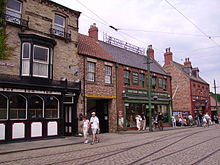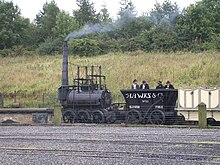North of England Open Air Museum
The North of England Open Air Museum (German: "Nordengland-Freilichtmuseum"; also Beamish Museum for short ) is an open-air museum in County Durham in the United Kingdom . The place in the museum is named Beamish like a neighboring place . In 1987 the museum was named European Museum of the Year .
geography
The museum is located southwest of the city of Newcastle upon Tyne in north east England . The site covers 120 hectares.
history
In 1958, the later museum director Frank Atkinson (1924-2014) campaigned for the living and working conditions of the 19th and 20th centuries in north-east England to be presented in a museum for posterity. In 1970 the area for the museum was acquired and opened to the public in 1972. Operators are the county and nine of its cities. Around 95 percent of the operating costs are covered by the income from entrance fees, souvenirs and sales of the products and the Friends of Beamish association founded in 1968 . The remaining costs are borne by the operator, the state and the EU . Around 350,000 visitors visit the museum every year.
construction
The museum consists of several building complexes that are embedded in the landscape. Most of the buildings are replicas or come from the region. The greater part of the facilities shows life in north-east England in 1913, a smaller part is based on life in 1825. The past is depicted vividly not only through exhibits, but also through costumed actors and historical means of transport.
The town"
The "city" consists of a Victorian-style street that is supposed to represent the year 1913. In the city there is a grocery store, a confectionery factory including a shop, an engine workshop with a small car exhibition, a dentist's office, a printing shop, a bank, a restaurant, the house of a music teacher, the office of a lawyer and stables. A tram drives through the street .
The "Home Farm"
The farm is a replica that is also said to represent the year 1913. It includes several buildings that were typical of that time.
Coal Mine and Settlement
Components of an earlier coal mine, which had its original location there, are the pit's headframe including machine buildings and vehicles. The tunnels of the pit are accessible. Next to the mine is a small miners' settlement including a garden, a school building and a Methodist chapel . This section also represents the year 1913.
The station
This is where Rowley's double-track land station near Consett in County Durham was reconstructed from 1867. Some outbuildings and exhibits typical of the railway originate from other railway stations in the region. The museum station has a waiting hall, a waiting room for women and a ticket office. Next to the station you can see signals, a car hall, a weighing station and coal bunker. In addition, numerous items of freight and a replica of a C 060 locomotive from 1889 are on display.
Pockerley Waggonway
The Pockerley Waggonway railway system, part of the eastern section of The Georgian North, includes a replica of the Steam Elephant from 1815, which is not roadworthy. The original was built by William Chapman and was in service until 1840. In contrast, the replica of the Locomotion No.1 by George Stephenson is ready to go. The original ran from 1825 on the Stockton and Darlington Railway .
Pockerley Manor
This manor, which also belongs to the Georgian North , represents the year 1825. The house shows the living conditions at that time. It does not have a connection to the mains. A garden typical of this period is attached to the house. This area is closed off by a horse paddock. This part of the museum is only open in the summer months.
Trams, trolleybuses and buses
The museum has several historic trams from various cities in the area, which are used to transport visitors to the museum. It runs clockwise through the site every 20 minutes on a circular train. Numerous stations are served. The line was opened on May 24, 1973 on a 600 meter long section between the tram depot and the train station. In 1985 it was extended to “City”. The following year the depot was extended to the new visitor center. On June 24, 1993, the last part of today's ring was opened. The railway has a total of seven trams and two trolleybuses . A historical omnibus runs between the coal mine and the “city”.
| number | original location | Construction year | in the museum since | in use since |
| 1 | Gateshead | 1925 | 1968 | 1973 |
| 2 | Sunderland | 1900 | 1989 | 2003 |
| 3 | Blackpool | 1902 | 1984 | 1988 |
| 4th | Newcastle | 1901 | 1987 | 1996 |
| 5 | postage | 1935 | 1989 | 1992 |
| 6th | Sheffield | 1907 | 1967 | 1975 |
| 7th | Sheffield | 1950 | 1976 | 1983 1 |
| 8 2 | Keighley | 1924 | 1988 | - |
| 9 2 | Newcastle | 1948 | 1974 | - |
1 in Blackpool since 2001 2 trolleybus
See also
Web links
- Official website of the museum (English)
Individual evidence
- ↑ Frank Atikinson - obituary. Obituary in The Daily Telegraph, January 11, 2015 (accessed January 12, 2015).
- ↑ Official website of the museum , accessed December 14, 2009 (English)
- ↑ Information on the means of transport ( Memento from September 18, 2010 in the Internet Archive ), accessed on December 4, 2015 (English)
Coordinates: 54 ° 52 ′ 55 " N , 1 ° 39 ′ 30" W.


